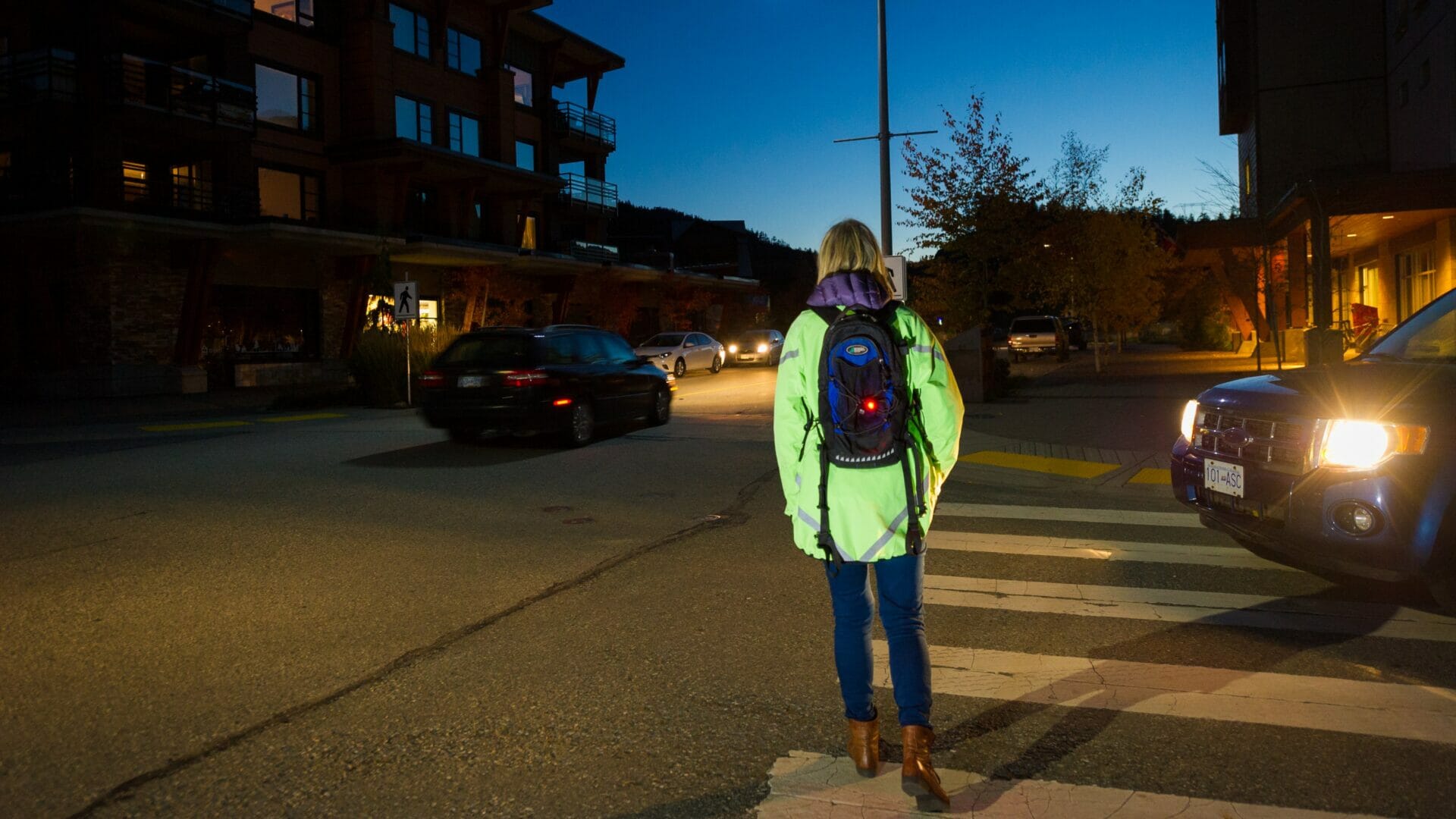Dress to be seen.
Free snowflake reflectors are available at Municipal Hall (4325 Blackcomb Way) or Meadow Park Sports Centre (8625 Highway 99).
Did you know?
In B.C., an average of 52 pedestrians are killed and 2,400 injured in 2,700 crashes every year. More than half (roughly 55 per cent) of fatalities occur between October and January. An average of 1,080 pedestrians are injured in crashes between October and January compared to 570 pedestrians who are injured between May and August. ICBC data based on five-year average from 2016 to 2020.
Let’s share the road safely
Walk safely
- Look. Always make eye contact with drivers. Never assume that a driver has seen you. Always walk facing traffic.
- Listen. Focus your full attention on what’s happening around you. Remove your headphones and never talk, text or use electronic devices while crossing the road.
- Dress to be seen. Wear reflective clothing or gear and carry a flashlight/torch to make it easier for drivers to see you. And attach a snowflake reflector to your pack.
- Be extra cautious at intersections. Watch for vehicles turning left or right through the crosswalk.
- Always cross at designated crosswalks – never mid-block. Follow pedestrian signs and traffic signals and never cross once the signal has turned yellow or red.
Drive safely
- Focus on the road, and stay off your phone or any other hand-held electronic devices while you’re driving.
- Be ready to yield to pedestrians – especially when turning in intersections and near transit stops.
- Look twice for pedestrians crossing the road particularly when visibility is poor.
- Give yourself extra time and space to stop in case a pedestrian suddenly crosses the street.
ICBC pedestrian safety information graphics:
Being visible amid Whistler’s dark skies essential for pedestrian safety

The Walk Safe program is a bold campaign with the goal of changing pedestrian behaviour at night and, ultimately, eliminating serious and fatal accidents between vehicles and pedestrians in Whistler. With darkness setting in early during the winter season, pedestrians need to ensure they are visible walking across or near roadways at night.
By taking simple precautions and understanding safety hazards, the community can reduce serious and fatal accidents between vehicles and pedestrians in Whistler.
Seasonal workers just arriving to Whistler are often surprised to see the beauty of surrounding mountains in the night sky. Lighting Whistler streets and roadways is designed to enhance the resort’s natural beauty, while the brightly-lit pedestrian walkways of the Village Stroll and parts of the Valley Trail guide residents and visitors to village amenities. However, transitioning from the Stroll across Highway 99 and into Whistler subdivisions, pedestrians may not realize how dark the streets are, and how drivers often have difficulty seeing walkers crossing roadways.
With this reality, candid messages for Walk Safe highlight how making yourself visible while walking across Whistler roadways at night can in fact, save your life. Using a reflector, head lamp, reflective clothing or staying on lit trails, using crosswalks and walking facing traffic can each make a huge difference for a pedestrian to be visible at night.
Partners
The Walk Safe public service campaign, initiated by the Whistler detachment of the RCMP and the Whistler Fire Rescue Service, was developed in partnership with the Resort Municipality of Whistler and the Whistler Blackcomb Foundation. Together, with support from local media, business owners and schools, Walk Safe aims to become an essential component of life in Whistler.
ICBC pedestrian safety campaign
The Insurance Corporation of British Columbia (ICBC) has launched a new education campaign across the province to help keep pedestrians safe this fall and winter when crashes involving pedestrians increase significantly in B.C.
On average, 76 per cent more pedestrians are injured in crashes from November to January every year when conditions are dark and weather is poor compared to June to August in B.C.
ICBC is partnering with TransLink, Transit Police and BC Transit with new advertising featured on SkyTrains and in buses across B.C. to reach pedestrians on transit.
ICBC and community policing volunteers throughout B.C. will also be handing out pedestrian safety reflectors and tips at events throughout the province to help educate pedestrians about the importance of being visible to drivers in dark, fall conditions.

